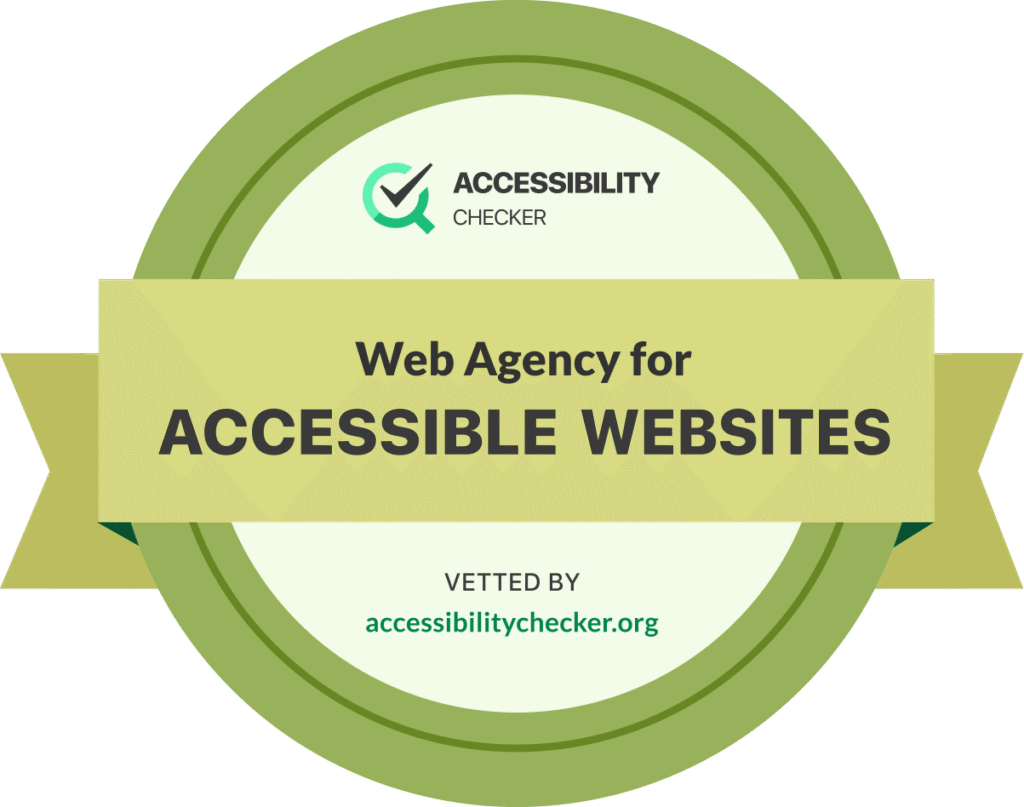Accessibility-Focused Web Design Agency
A Web Design Agency That Actually Prioritizes Accessibility
Meet Azuro – a premium web design agency with a relentless commitment to accessibility compliance (WCAG 2.2 AA).
Many companies don't realize that their foreground and background colours don't have accessible contrast levels. We ensure proper colour contrast (and font sizes).
ARIA Landmarks
Enable assistive technologies to provide users with a navigable list of key regions on your site. We optimize your code manually so that nothing gets missed.
Image Alt Text
Not everyone has the luxury of seeing the images on your site, so it's important for each image to have "alternative text" that describes the image in detail.
Accessible Forms
Pick an accessible form plugin, add clear and visible field labels, enable accessible error messages and test with keyboard navigation (and screen reader).
Keyboard Navigation
We do a sitewide audit to ensure that all pages are fully accessible and streamlined for users that rely on keyboard navigation. Manual remediation is often required.
Screen Reader Friendly
Users with visual impairments rely on screen readers and must be prioritized for compliance and to boost overall website engagement. Semantic HTML is key.

Inclusive Website Experiences for All
Our team believes that focusing on accessibility is not only a moral and legal obligation, but also a way for our clients to increase website engagement and enhance their reputation.

We're a Verified Leader in Web Accessibility
AccessibilityChecker.org has recognized Azuro Digital as a verified web agency for accessible websites. Accessibility laws like ADA and AODA are increasingly enforced. By partnering with Azuro, not only will you avoid fines, but you'll also attract a whole new audience to your site.
Helpful Guides & Tools
Your Questions, Answered
What makes a website truly accessible?
A truly accessible website ensures that all users, regardless of their abilities or disabilities, can navigate, understand and interact with your content effectively. This means implementing proper semantic HTML structure, providing alternative text for images, ensuring sufficient colour contrast ratios (at least 4.5:1 for normal text), making all functionality available via keyboard navigation and screen readers, and including captions for video content. Accessible websites also feature clear heading hierarchies, descriptive link text, and forms with properly labeled fields. Beyond technical requirements, accessibility involves thoughtful design decisions like avoiding flashing content that could trigger seizures. True accessibility also means your website is usable across different devices and connection speeds, creating an inclusive experience for users with visual, auditory, motor, or cognitive disabilities – no matter what device or connection speed they’re using.
Why should my business invest in accessible web design?
Investing in accessible web design isn’t just ethically important – it’s smart business. First, you’re expanding your potential customer base significantly. Over one billion people worldwide live with some form of disability, representing substantial purchasing power that many businesses overlook. Second, accessibility and SEO go hand-in-hand. Many accessibility best practices, such as semantic HTML, descriptive headings, and alt text, also improve search engine rankings. Third, you’re reducing legal risk. Laws like the Americans with Disabilities Act (ADA) and the Accessibility for Ontarians with Disabilities Act (AODA) require many organizations to maintain accessible websites, and lawsuits over inaccessible websites have increased dramatically in recent years. Additionally, accessible websites typically offer better user experiences for everyone – features like captions benefit users in sound-sensitive environments, and clear navigation helps all visitors find information quickly. Finally, demonstrating commitment to accessibility strengthens your brand reputation and shows that your organization values inclusivity and social responsibility.
How do you ensure websites meet WCAG compliance?
Our approach to WCAG (Web Content Accessibility Guidelines) compliance is comprehensive and thorough. We build accessibility into every phase of the design and development process rather than treating it as an afterthought. During the design phase, we select colour palettes with sufficient contrast, create layouts that work with various text sizes, and design intuitive navigation patterns. During development, we implement proper semantic HTML, ARIA labels where appropriate, keyboard navigation support, and ensure compatibility with assistive technologies. We conduct testing using both automated tools and manual evaluation, including keyboard-only navigation testing, screen reader testing with tools like JAWS and NVDA, and real-world testing with users who have disabilities when possible. We perform audits against WCAG 2.2 Level AA standards (or Level AAA when required), documenting any issues and implementing fixes. After launch, we provide guidance on maintaining accessibility as content is updated and can offer ongoing monitoring and support to ensure your website remains compliant as standards evolve.
What's the difference between accessible design and universal design?
While these terms are related and often used interchangeably, there’s a meaningful distinction. Accessible design specifically focuses on making products and environments usable by people with disabilities – it’s about removing barriers for specific groups. Universal design, however, takes a broader approach by creating solutions that are usable by all people to the greatest extent possible, without requiring adaptation or specialized design. Universal design benefits everyone: automatic doors help wheelchair users but also parents with strollers and delivery workers with packages. In web design, this means creating interfaces that work seamlessly whether someone is using a mouse, keyboard, touchscreen, or voice commands. Our agency embraces universal design principles because they lead to more flexible, intuitive websites that serve diverse users across different contexts and abilities. When we design universally, we’re not just accommodating disabilities – we’re acknowledging that human diversity is the norm and creating digital experiences that respect and support that reality.
What happens after our accessible website launches?
Launching an accessible website is just the beginning of an ongoing commitment to digital inclusion. After launch, we provide comprehensive documentation detailing your website’s accessibility features and how to maintain them as you add new content. We offer training sessions for your team, teaching content creators and administrators how to write accessible copy, add images with proper alt text, create accessible PDFs, and maintain the accessibility standards we’ve established. Many of our clients opt for ongoing support agreements where we conduct periodic accessibility reviews – quarterly or annually – to ensure your site remains compliant as you make updates and as accessibility standards evolve. We also provide guidance on establishing internal accessibility policies and workflows. Additionally, we can help you create an accessibility statement for your website that demonstrates your commitment to inclusion and provides users with a way to report any barriers they encounter. We believe accessibility is a journey, not a destination, and we’re committed to being your partner throughout that journey.
Can you handle accessibility for complex features like interactive maps, charts & videos?
Yes!
Complex interactive elements require thoughtful accessibility strategies that go beyond basic compliance. For interactive maps, we implement multiple input methods (mouse, keyboard, and touch), provide text-based alternatives listing all locations, ensure proper focus management as users navigate, and include zoom functionality that works with screen magnification tools.
For data visualizations and charts, we provide accessible data tables as alternatives, use patterns in addition to colour to convey information, include detailed text descriptions of trends and insights, and ensure interactive elements can be operated without a mouse.
Video content receives synchronized captions (not just automatic captions, which are often inaccurate), audio descriptions for visual information not conveyed through dialogue, and transcript files that users can download or read alongside the video.
For dynamic content that updates without page refreshes, we implement ARIA live regions to announce changes to screen reader users.
We approach each complex feature by asking: how would someone interact with this if they couldn’t use a mouse, couldn’t see the screen, or couldn’t hear audio? Then we build solutions that provide equivalent experiences through alternative means, ensuring no user is excluded from your website’s full functionality.






